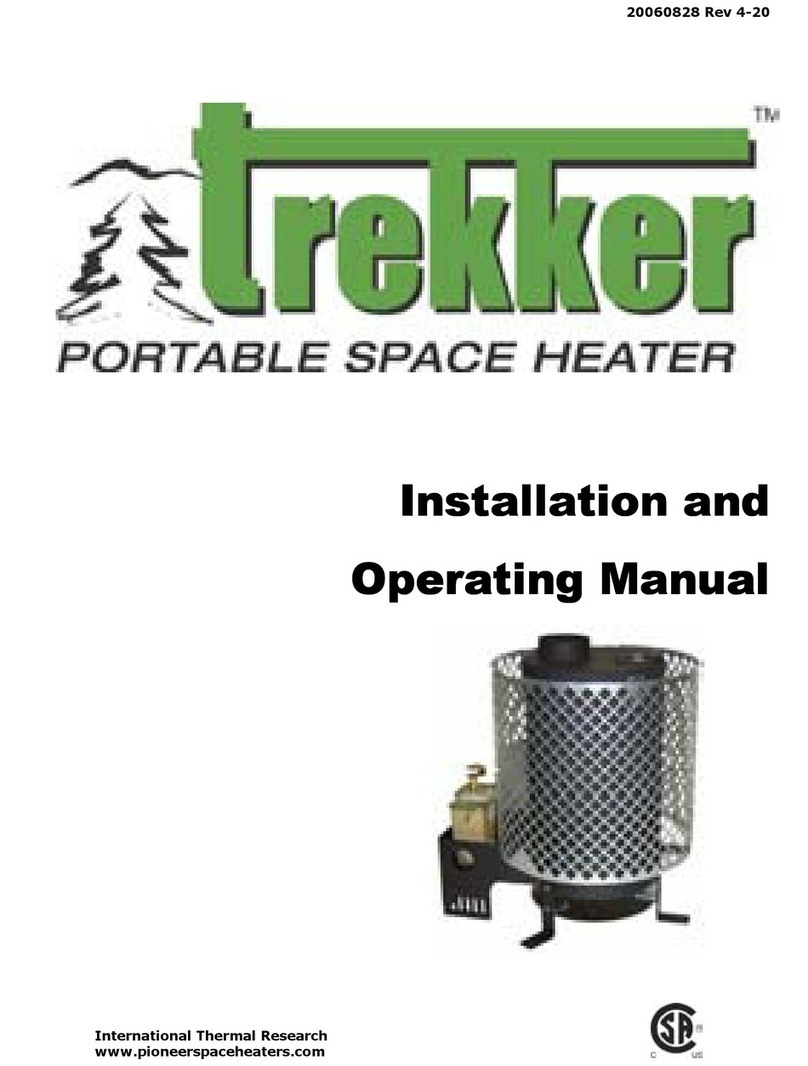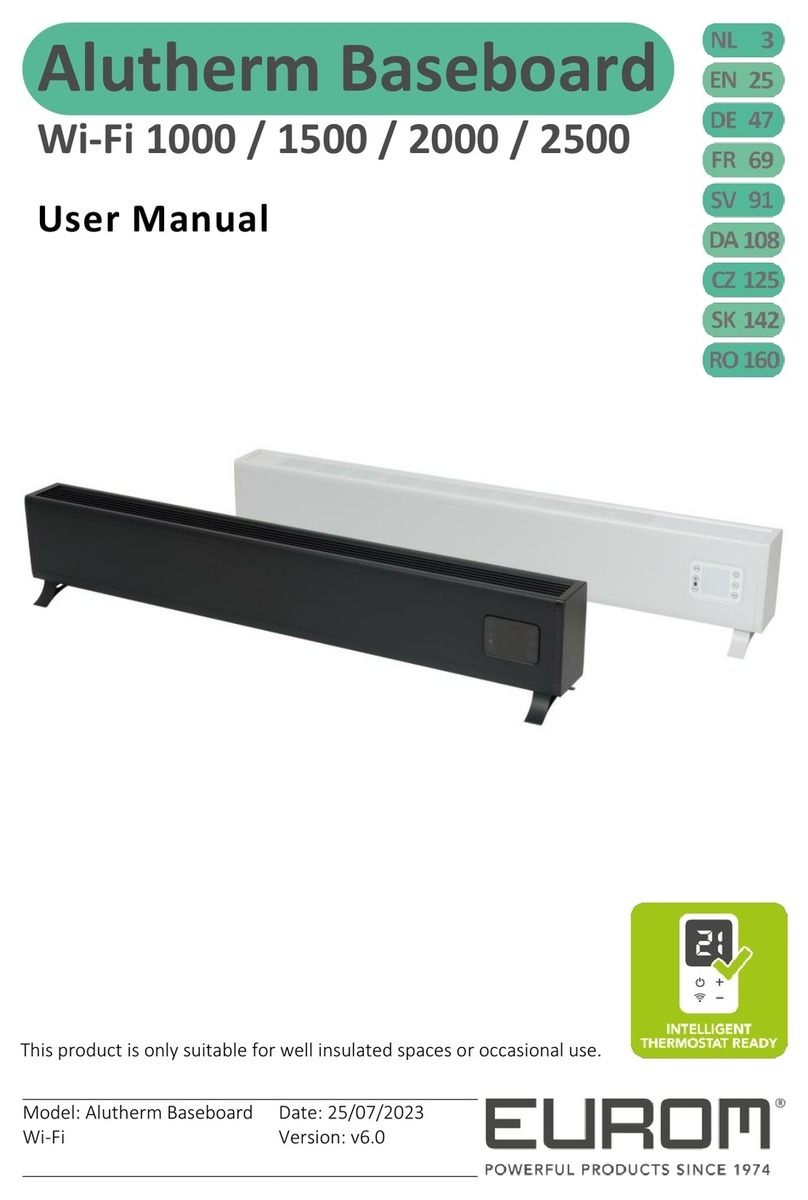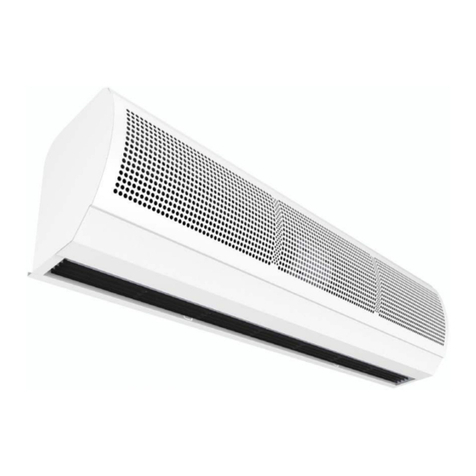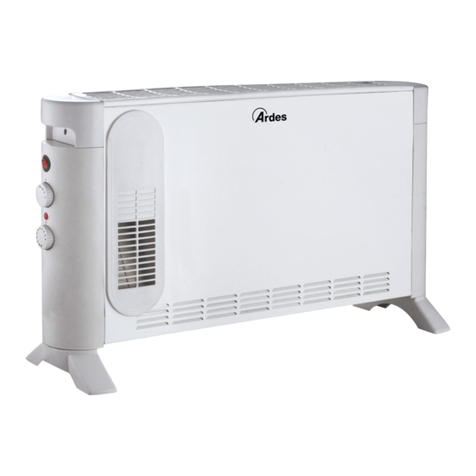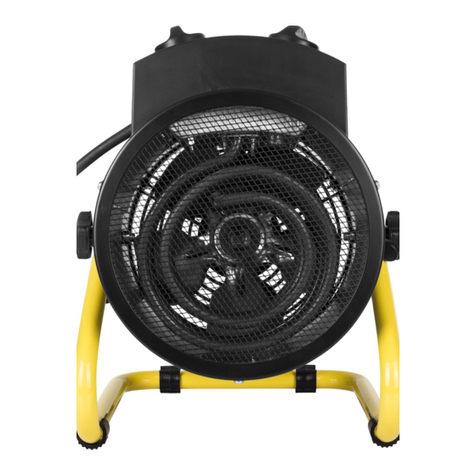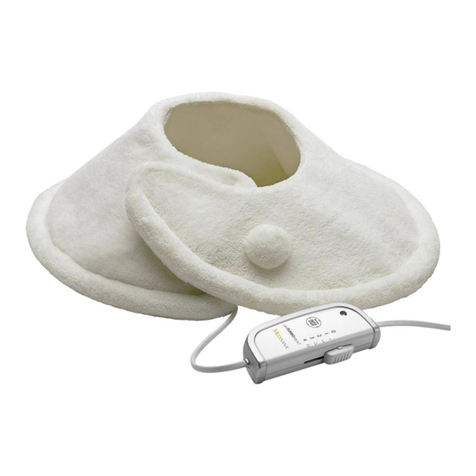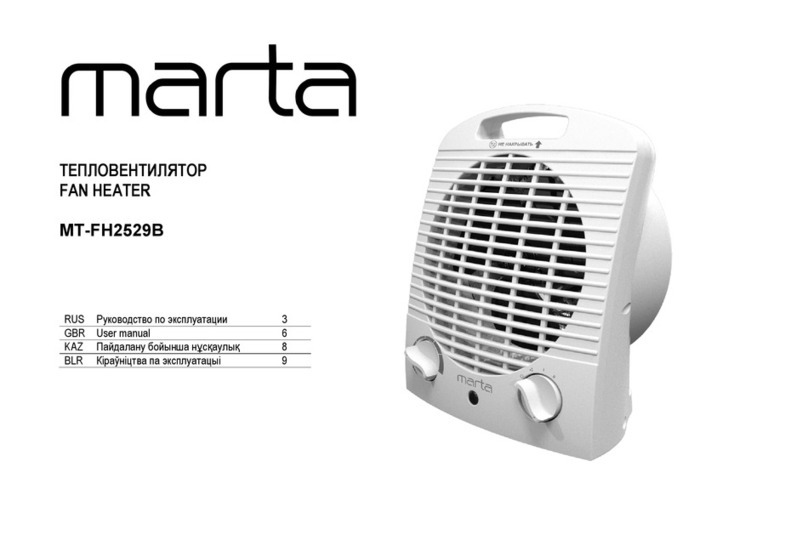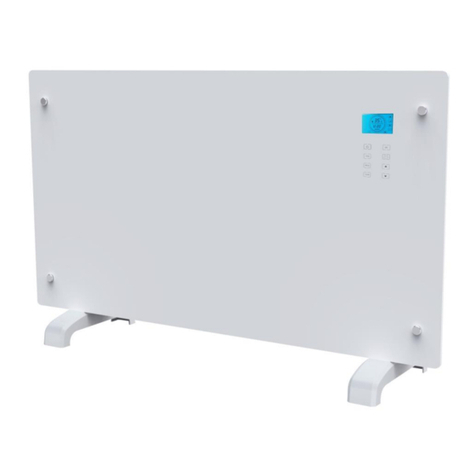International Thermal Research Prospector User manual

20050914 rev5-30
International Thermal Research
www.pioneerspaceheaters.com i
Installation and
Installation and Installation and
Installation and
Operating
Operating Operating
Operating M
MM
Manual
anualanual
anual

ii International Thermal Research
Table of Contents
Table of ContentsTable of Contents
Table of Contents
Table of Contents .........................................................................i
Table of Contents ........................................................................ ii
Overview....................................................................................1
1. Safe Operation ......................................................................1
2. DOs and DO NOTs .................................................................2
3. Components..........................................................................4
4. Installation ...........................................................................6
5. Operation .............................................................................
6. Oil Control Valve.................................................................. 11
7. Maintenance ....................................................................... 12
8. Trouble Shooting ................................................................. 14
READ T ESE INSTRUCTIONS AND SAVE FOR FUTURE REFERENCE

International Thermal Research
www.pioneerspaceheaters.com 1
Overview
OverviewOverview
Overview
Thank you for purchasing International Thermal Research’s
(ITR) Prospector space heater.
The Prospector Heater is a vaporizing-type oil burner space
heater with a simple, effective design that produces radiant
and convection heat through the efficient combustion of liquid
fuel. With regular maintenance and proper operation your
heater will function satisfactorily for many years.
The heat output range for your Prospector heater is 20,000 to 55,000 BTU’s. This is
sufficient capacity to heat areas such as cabins, workshops, small warehouses, etc.
Table 1: General Information
Oil Consumption Chimney draught
Nominal heat
output min max min Max Weight Flue diameter
55,000 BTU/Hr 0.32 US Gal/h 0.55 US Gal/h .050” W.C. .060” W.C. 58 Lbs Ø6 inches
16,1 kW 1,20 Liter/h 2,10 Liter/h 12,5 Pa 15 Pa 26 kg 152,4 mm
1.
1.1.
1. S
SS
Safe
afeafe
afe Operation
Operation Operation
Operation
Proper installation, operation and maintenance procedures laid out in this manual, as
well as local government requirements, must be followed to insure the safe operation of
your Prospector. CSA standard B13 , Installation Code for Oil Burning Equipment,
UL8 6, or NFPA#31 are standards that apply to this equipment.
Make sure you read, and understand these instructions and save them for future
reference. If you have any questions or don’t understand anything in this manual,
contact your authorized ITR dealer.
Make sure you read and
understand this manual
before installing and
operating your
Prospector. If you have
any questions, or
require any explanation,
please contact your
authorized ITR dealer.

2 International Thermal Research
2.
2.2.
2. DOs and DO NOTs
DOs and DO NOTsDOs and DO NOTs
DOs and DO NOTs
All heaters must be installed according to the installation rules mandated by local,
state/provincial and federal government authorities. These regulations deal with
various matters including heater and flue set backs and fuel storage. DO determine
what regulations apply in your local area. DO NOT install the heater or flue unless
installation conforms with the regulations governing your location.
All heaters and stoves, whether they burn solid or liquid fuel, exist for one reason –
to produce heat. Therefore common sense says that all heater parts will be hot when
the unit is operating. DO NOT touch heater parts if the heater is running. You’ll get
burned.
Your heater is designed to burn clean #1 and #2 diesel fuel. If you burn any other
fuel or burn contaminated diesel, you will void your warranty, cause damage to the
fuel control valve (Toby) and may cause a fire or even an explosion. DO use only the
right fuel. DO NOT use any other fuel, under any circumstances.
Fuel delivery from the tank to the heater is important. Any fuel leaks can result in a
dangerous fire. DO inspect the entire fuel line for leaks before firing the heater. DO
NOT start the heater until any leaks are properly fixed.
All fuel burning heaters require oxygen to operate and they get that oxygen from the
air. DO inspect the space below the burner to make sure there are no blockages and,
if there is any dust or dirt remove it. DO inspect the exhaust flue (stove pipe) to
make sure it is not blocked. DO NOT start the heater until any blockages have been
removed.
Oxygen for combustion comes from the air in the same space as the heater and as
that air is used in the combustion process it goes up the exhaust flue. Since you are
also in the same space as the heater, if the air in the room is not replaced, all the
oxygen needed to keep the heater burning, and you alive, will run out. DO make
sure that you have a window or door opened a bit to allow fresh air to enter. DO
NOT operate the heater in an air tight room. To do so will lead to oxygen deprivation
and, if the condition continues, will result in death.
If, after the heater has been fired, you smell smoke or exhaust fumes, shut the
heater down immediately and examine the stove pipe for leaks or sloppy fitting. DO
NOT continue to operate the heater until any leaks are repaired. The fumes are
poisonous. DO vent all exhaust gases outside.
DO NOT ever attempt to relight the heater when it is hot. If the unit is shut down for
any reason DO wait until it cools down to room temperature before re-firing.
DO mount the heater securely to a non-combustible floor. If a heater is not solidly
secured, and it gets knocked over, it will spill the burning fuel all over the floor. This

International Thermal Research 3
will create a serious fire hazard that could burn down the building housing the heater.
DO NOT start the heater until it is properly secured.
All liquid fuel heaters run best when they are level. DO make sure your heater is
level before you start it.
All heaters, regardless of the type or make, can malfunction and all manufacturers
recommend that heaters are not left running unattended. DO NOT leave the heater
running unattended. The Prospector is mechanically capable of operating
unattended, but if there is a malfunction ITR accepts no responsibility or liability for
any damage caused, regardless of the type or extent of the damage. T IS
PARAGRAP CONTAINS LANGUAGE T AT LIMITS T E MANUFACTURER’S
LIABILITY.
DO install carbon monoxide and smoke detectors in the same room as the heater;
The Canadian Standards Association (CSA) has some additional consumer tips for
space heaters which ITR agrees with.
Some of those tips are:
DO NOT hang wet clothing above the heater to dry it. The clothing can catch
fire as it dries
DO supervise young children when in the same room as the heater
DO NOT keep gasoline, solvents or other flammable or vapourizing liquids in
the same room as the heater.
More tips can be found on http://www.csa.ca/consumers/consumer_tips/.

4 International Thermal Research
3.
3.3.
3. Components
ComponentsComponents
Components
A.) Prospector major external components
eater Shell (1) – The
heater shell assembly is the
area of the heater
containing the perforated
burner shell.
Top Lid (2) – Contains a
sight glass to observe the
flame.
Guard (3) – Perforated
shield surrounding the
Prospector
Valve eat Shield (4) –
Shield between control valve
and burner shell.
Toby Oil Control Valve (5) – Located on the side of the heater and controls the
amount of gravity fed fuel supplied to the burner. Turning the control knob will
allow more or less fuel to enter the burner. See sections 5 & 6.
Drain Valve (6) – To fill up the primer cup or to drain fuel from the control valve.
Fuel Connection (7) – ¼” NPT female threaded fitting
Fuel shut off valve (8) – Opens or closes the flow from the fuel tank to the Oil
Control Valve.
Flue Collar ( ) – To attach a Ø6” Flue stack.
Reamer Tool (10) – To clean the Up-Tube from soot and carbon build up.
Primer Cup (11) – Attached with a chain and used to start-up the heater.
Removable andle (12) – Used to open the lighting port or top lid. Do not leave
the handle on the unit when heater is running. Handle gets too hot to touch.
Draft regulator (13) – To maintain a stable draft

International Thermal Research 5
B.) Prospector major internal components
Up–Tube (20) – Receives fuel from the oil control valve and permits fuel vapours
to flow into the S-Tube (25) during operation.
igh Fire Ring (21) – Clean below High Fire Ring periodically, remove any build
up of soot or hard carbon deposits and vacuum.
Burner Shell (22) – Area of the heater where combustion occurs. The perforated
Burner Shell contains an up-tube (20) welded to the base of the shell and a
removable, capped S–Tube (25) which sits over the welded up-tube. The Burner
Shell is permanently mounted inside the Burner Shell Assembly (1) and can be
accessed by removing the Top Lid (2).
Burner Base (23) – Bottom of Burner Shell (22). Periodic cleaning from soot and
carbon build up required.
Burner eat Shield (24) – Heat shield to keep heat inside the Burner Shell and
away from the bottom of the Prospector Unit.
S-Tube (25) – The large capped tube in the center of the perforated Burner Shell
is the S-Tube. The S-Tube is positioned over the welded Up-Tube (20) and is fully
removable through the top burner lid opening. During operation, fuel flows
through the Up-Tube (20) where its level is gravity maintained with the Toby
Control Valve (4). Fuel vaporizes due to combustion heat and is expelled from the
up-tube, down through the S-tube and into the perforated burner shell where it
ignites.
Note: If any parts appeared damaged, do not operate the heater. Contact your
authorized Prospector Dealer.
When unpacking the heater, remove any packing material from the side of the
burner canister and around the air intake area.

6 International Thermal Research
.
..
. Installation
InstallationInstallation
Installation
A.) Location and Mounting
The Prospector heater may be placed on a flat level surface made of material
that can resist heat. Hardwood, plywood, concrete, etc. are acceptable. The
Prospector should not be mounted directly on a carpeted floor. Use a solid
platform or rigid heat resistant material between the carpet and the heater.
Ideally a large open space would best suit the heater. The surfaces of the heater
and the flue stack will be generating heat and should be taken into consideration
when mounting the heater.
The minimum standard clearance between the heater and any building
construction other than the floor is 36 inches ( 1 cm). The minimum standard
clearance between the exhaust vent pipe and any building construction is 18
inches (45 cm).
An unlevelled heater will not operate properly and could be dangerous. Adjust the
heater perfectly level in all directions before mounting.
The heater should be securely mounted to the floor. The legs contain a ¼” hole
for directly fastening the heater to the floor.
B.) Exhaust Flue Stack
OIL BURNING APPLIANCES MUST BE CONNECTED TO FLUES HAVING SUFFICIENT DRAFT
AT ALL TIMES TO ASSURE SAFE AND PROPER OPERATION OF THE BURNER.
All heaters must be installed according to the installation rules mandated by local,
state/provincial, and federal government authorities. These regulations deal with
various matters including heater and flue set backs and fuel storage. DO
determine what regulations apply in your local area. DO NOT install the heater or
the exhaust flue stack unless the installation conforms with the regulations
governing your location.
The Prospector does not come with an exhaust flue stack. Blue stove pipe or All-
Fuel “L” type vent capable of continuous use for flue gas temperatures up to
1000˚F may be used. Always use flue stacks that are at least the same diameter
as the flue collar on the heater. Appropriate parts for the appropriate flue stack
must be purchased at your local heating and ventilation companies. As all
installations differ, it is necessary that you follow all local, state/provincial, and
federal guidelines in selecting the type, method, and location of the exhaust flue
stack for your particular situation.

International Thermal Research 7
Before hooking up the Prospector to a chimney, check if the chimney is in good
condition and that the quality of the flue pipe will allow sufficient draft. A
maximum horizontal length of 6’ is allowed. Make sure to have a ¼” slope per
foot minimum. Do not use more than two 0° elbows for connecting stove to
chimney.
The recommended draft for the Prospector is between .040-.060 inches water
column. This is measured 18” (45cm) up the stack and before the draft regulator.
The minimum flue stack height is 12 feet (3,6m).
The chimney flue should extend at least
2’ (0,6m) above the highest roof surface
or structure within 10’ (3,0m)
horizontally of the chimney to prevent
down drafts.
Attach the female part of the flue pipe to
the heater using 3 self tapping screws
spaced equally around the pipe.
Install the included draft regulator which
is necessary in order to maintain stable
draft in certain conditions.
Read the installation and adjusting
instructions which are packed in the
carton of the draft regulator before
installing.
The Prospector emits very little carbon and soot into the flue system. However it
may be convenient to design your flue system so it can be brushed clean if
necessary.
For safe operation, it is highly recommended that the installed exhaust system be
inspected by a qualified professional to ensure the suitability of the type and
method of the installation.
During operation, the heater produces harmful carbon monoxide (CO) and other
gases. To prevent CO poisoning, ensure the exhaust stack sections fit together
snugly and that the exhaust gases are properly vented through the roof of the
structure.

8 International Thermal Research
C.) Venting and Air Supply
The heater consumes about 4000 ft3 of air per 1 US gallon of oil. This air enters
the heater through the air inlets and exits the chimney as combustion gas.
The Prospector should be installed in a well ventilated area that allows the
entrance of outside fresh air.
Connecting to Oil Tank
The external oil tank is to be installed in accordance with the manufacturer’s
instructions and the Standard to which the tank has been manufactured.
Make sure that the tank outlet is 12” (30 cm) higher than the inlet of the oil
control valve. (Gravity fed)
A good quality filter should be placed at the tank to ensure a good clean supply of
oil to your heater.
When the tank is installed outdoors, it is preferable to use oil #1, to avoid any
viscosity problems.
The fuel line can be connected to the oil control valve using a ¼” NPT male fitting.

International Thermal Research 9
INSTALLATION OF THE HEATER, FLUE STACK AND FUEL TANK MUST BE INSTALLED IN
ACCORDANCE WITH THE REGULATION OF AUTHORITIES HAVING JURISDICTION, NFPA
#31, CSA STANDARD B13 . AND UL8 6.
5.
5.5.
5. Operation
OperationOperation
Operation
The Prospector heater requires a break in period between 1 and 2 hours. During this
period, some smoke and fumes may be generated from the heater shell itself; make
sure there is enough ventilation for the smoke and fumes to escape the living or
operating areas.
A.) Starting the Prospector eater
To start the Prospector Heater:
DO NOT USE ANY UNAUTHORIZED FUELS OR MIX DIFFERENT FUELS. ONLY CLEAN
UNCONTAMINATED DIESEL #1 OR #2 FUEL IS TO BE USED. USING ANY OTHER FUELS
COULD CAUSE A FIRE AND/OR EXPLOSION. DO NOT USE GASOLINE, CRANKCASE OIL,
OR ANY OIL CONTAINING GASOLINE.
•Check for any leaks in the fuel system. Locate and repair any leaks and/or clean
any spills before igniting the heater.
•Check the exhaust flue stack for any blockage or anything that might obstruct the
exhaust gases. The flue stack must be vented outdoors. Do not let any exhaust gas
flow into any living or operating areas.
•Check the exhaust flue stack and the attachment point to the heater for any leaks.
Correct any problems before igniting the heater.
•Check the airway around the base of the heater to ensure that the heater receives
a clear, unobstructed supply of combustion air.
•Open the fuel shut-off valve from the fuel tank.
•Lift up on Toby Valve Actuating Lever to let fuel run into the float bowl of the valve.
•Place the primer cup below the fuel drain valve located beside the Toby valve.
Open the drain valve and allow the fuel to drain into the
primer cup. Close the drain valve once the cup is full.

10 International Thermal Research
•Open the lighting port lid on the side of the burner shell
and insert the cup inside the heater to the gap just beyond
the high fire ring and before the circular plate. Pour the
contents of the cup onto the burner base by turning the
cup upside down. This will create a puddle of fuel at the
burner bottom. Do not pour the fuel onto the ring or
circular plate.
•When the burner is being lit, it is usually desirable to use a
match or gas lighter and a small ball of tissue paper for
lighting. Use the paper to clean the primer cup of the
remaining oil and place it in the cup.
•Insert the cup with the paper inside the burner through the
lighting port and position it at the same position as the
“pour” position. Light the paper and turn the cup upside
down so that the burning paper lands in the puddle of fuel
at the bottom of the burner.
•Take the primer cup out and close the lighting port.
•Place the control knob on the Toby control valve to the first raised “I” mark setting
(LOW) next to the “O” mark.
•Wait ten to fifteen minutes for the flames to settle down and turn blue before
setting the control knob on the Toby control valve to your desired temperature. The
“0” is the OFF setting and a half turn counter clockwise is the highest fuel setting
on the burner.
•If the flame dies out, wait for the heater to cool down to room temperature before
repeating the starting procedures.
DO NOT ATTEMPT TO START OR RE-IGNITE THE BURNER WHEN THE BURNER IS HOT.

International Thermal Research 11
•Do not leave a heater running unattended. ITR accepts no responsibility for any
damages caused by leaving the heater running unattended.
B.) Turning off the Prospector eater
To turn off the Prospector Heater:
•Turn the control knob on the TOBY Oil Valve to the OFF position marked “0” on the
lid.
•Turn off the Fuel Shut Off Valve from the fuel tank to the heater.
•The flame will die out in about five minutes.
ALWAYS KEEP THE OIL VALVE TURNED OFF WHEN THE HEATER IS NOT OPERATING.
6.
6.6.
6. Oil Control Valve
Oil Control Valve Oil Control Valve
Oil Control Valve
A.) Toby Oil Valve
The TOBY Oil Valve is a continuous flow level control valve designed for controlling
fuel flow to the Prospector heater.
TOBY Oil Valves are factory preset to work with your heater. Do not tamper with
it. If you have questions or concerns, please contact your authorized Prospector
Dealer.
TOBY Oil Valves are very simple to operate; the key parts to operating a TOBY
Valve for the Prospector are the Control knob and the actuating lever. The
control knob controls the fuel flow rate and can be rotated counter clockwise from
the off position, which is the “0” marked on the lid to the high fire position, which
is the last “I” mark on the lid. The Toby Valve Actuating Lever allows fuel to run
into the float bowl of the valve when it is placed in an up position.

12 International Thermal Research
B.) Toby Valve safety features
The TOBY Oil Valve has two safety features incorporated into the design of the valve.
•High temperature fuel cut off system. If the temperature of the fuel
exceeds 100 degrees Celsius (212 degrees Fahrenheit), fuel will be shut off
at the outlet of the valve. Once this occurs, the valve is no longer operable
and a new valve is required for the heater to operate.
•Tilt levelling switch. The Toby Oil Valve will shut off at the outlet of the
valve when the angle of the valve exceeds the following: lengthwise 5
degrees, width wise 15 degrees.
Toby Valves are ULC Listed and DIN approved. The Toby valve requires no
maintenance and has no user serviceable parts.
7.
7.7.
7. Maintenance
MaintenanceMaintenance
Maintenance
A.) Regular Maintenance
To ensure that your Prospector heater operates properly;
•every 750 hours of operation or;
•if the output of the heater appears to be have decreased from the same
valve setting or;
•if the exhaust exhibits smoke
perform the following maintenance:
•In normal operation, carbon and soot will accumulate in the area of
the burner base, heater up tube or underneath the high fire ring.
These deposits must be periodically removed.
•Working on a cold burner, ensure that the fuel control valve on the
heater and the fuel supply to the heater has been turned off. Remove
the burner lid and see if there is any soot around or on the
perforated burner shell or high fire ring. If so, brush off and vacuum
clean.
•Loosen and remove any carbon build up in the center up-tube itself.
Remove the bottom heat shield. Locate the clean-out plug at the
bottom of the burner shell assembly. Place the supplied fuel filler cup
below the opening of the clean-out threaded plug. Use a wrench and
remove the threaded plug from the bottom of the assembly. Any
quantity of fuel still present in the fuel line will drain into the filler

International Thermal Research 13
cup. Carefully insert the metal cleaning auger into the up-tube and
loosen any hard carbon deposits within the tube by using an
up/down twisting motion of the auger. This will loosen any deposits
and allow them to fall through the opening of the threaded plug. Do
not use a side to side motion or excessive force or you will
distort, bend, or break the welded up-tube. Continue until the
tube is clear of any accumulated deposits. Replace the clean-out plug
into the bottom of the burner shell assembly and re-tighten. A pipe
sealant or other appropriate sealing compound should be applied to
the threads. Check this threaded plug fitting for any leaks when the
heater fuel flow is again re-started. Re-tighten if necessary.
Additional regular maintenance items include:
•Check for any leaks in the fuel system, cracked hoses or suspect areas
where a leak might occur and correct.
•Check the flue stack for any damage or areas that might allow flue gases to
leak into your heating area and correct.
•Check the flue stack for any blockages and/or soot and remove and correct
•Check for fuel strainer blockage and replace if necessary
•The Toby valve requires no maintenance and has no user adjustable parts
B.) Storing the eater
On storing the heater for an extended period:
•Perform the previous maintenance steps
•Clean the heater with a rag and spray or wipe with a light mist of oil inside
the burner area and outside to prevent rusting.
•Drain all fuel lines and any fuel from the heater
ATTENTION: Regular maintenance is required for the Prospector heater to
perform as designed. Failure to maintain the heater as required will not only
void your warranty but can cause the heater to be dangerous to operate.

14 International Thermal Research
8.
8.8.
8. Trouble Shooting
Trouble ShootingTrouble Shooting
Trouble Shooting
A.) Symptom: Burner does not keep lit, flame shuts off.
Recommendations: On a cold heater
•Check for Fuel Shut off Valve in the ON position.
•Check the Control Actuator lever on the Toby Valve and ensure it is at the
on position by lifting it up. (This leaver does not stay up however)
•Check the Control Knob on Toby Valve is not set to “0” or OFF position.
•Check for incorrect or poor quality fuel.
•Check for blockages in fuel inlet. ( i.e. fuel strainer plugged and/or fuel line
to heater obstructed)
•Check for blockages in air inlet or exhaust outlet (flue stack).
•There may be air bubbles in fuel line. Give line a quick shake to dislodge
bubbles.
•Check for soot or carbon deposit that may have built up inside the up-tube,
under the high fire ring, or on the perforated burner shell.
B.) Symptom: eater does not provide adequate heat and flame appears
weak.
Recommendation: On a cold heater
•Check for incorrect or poor quality fuel.
•Check for adequate fuel supply. Ensure the fuel supply valve is open.
•Check fuel line or fuel strainer for blockage of fuel and correct as
necessary.
•Check sections of exhaust stack assembly for leakage or blockage and
correct as necessary.
•Check intake opening at bottom of heater for free airflow.
•Heavy winds or other weather conditions can increase the draft of the
heater. Ensure you have a draft regulator installed and it is connected
properly.
•Check for soot or carbon deposit build up inside up-tube, under high fire
ring, or on perforated burner shell.
•Check S-tube for proper seating on up-tube. Wait 30 minutes for heater to
cool down to room temperature before checking internal tubes.

International Thermal Research 15
C.) Symptom: eater rumbles and or flame appears high on top.
Recommendations:
•Set the Toby valve to a lower setting.
•Check for incorrect or poor quality fuel.
•Check bottom of heater for free airflow.
•Insufficient exhaust stack height could lower the draft of the heater; ensure
you have the recommended draft or consult with your authorized Pioneer
dealer for the need of a longer flue stack height.
Note: If Prospector heater is still not functional, contact your authorized
Prospector dealer or ITR.
ITR IN CANADA: ITR IN THE UNITED STATES:
2431 Simpson Road Suite D-3, 4018 NE 112 Ave.
Richmond, BC, Canada V6X 2R2 Vancouver WA USA 8682
Tel: 1-800-755-1272 or 604-278-1272 Tel: 1-800- 3-4402 or 360- 3-4877
Other manuals for Prospector
1
Table of contents
Other International Thermal Research Heater manuals
Popular Heater manuals by other brands
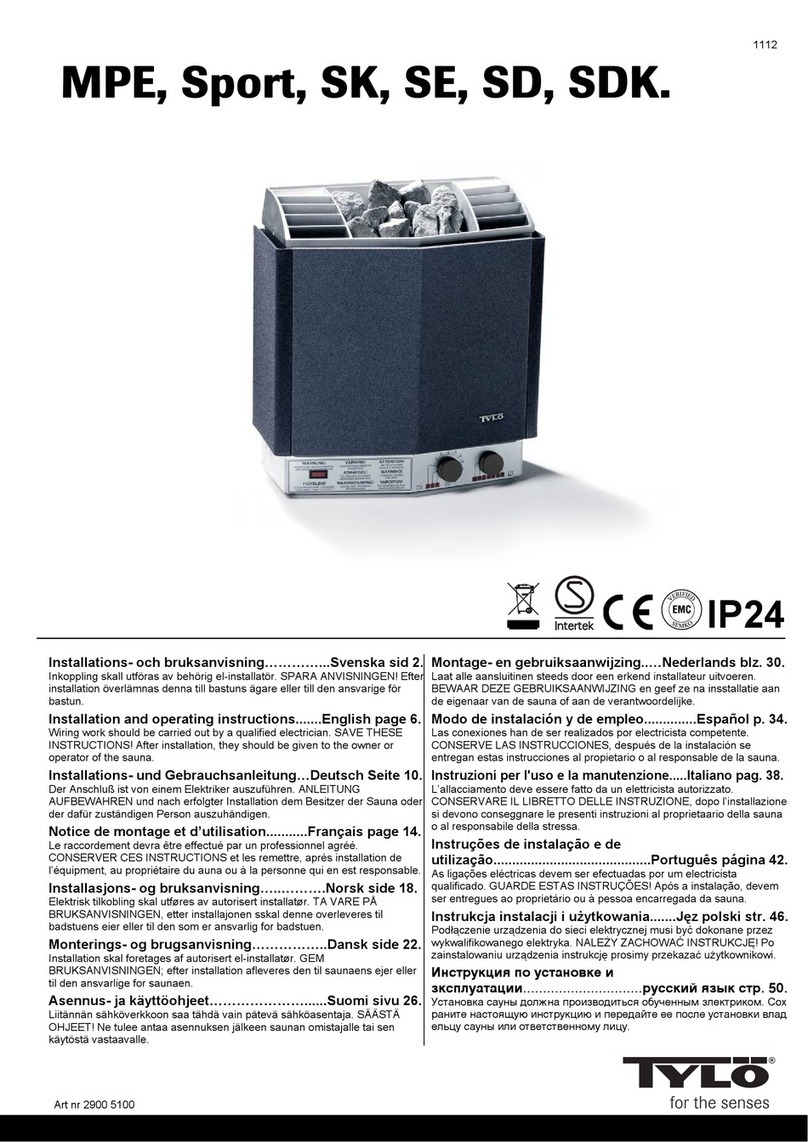
Tylo
Tylo MPE Installation and operating instructions
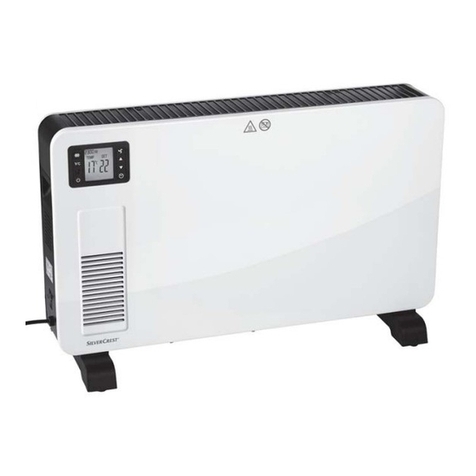
Silvercrest
Silvercrest SKD 2300 B2 operating instructions
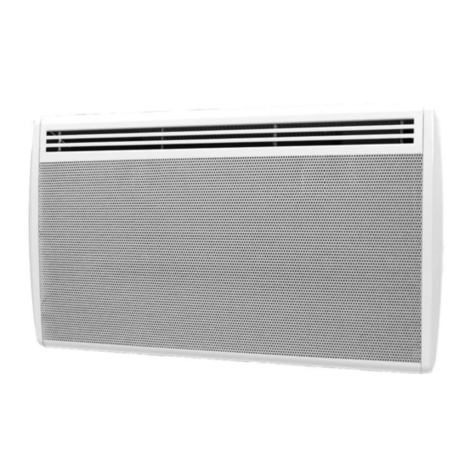
THOMSON
THOMSON THRAYF011D instruction manual
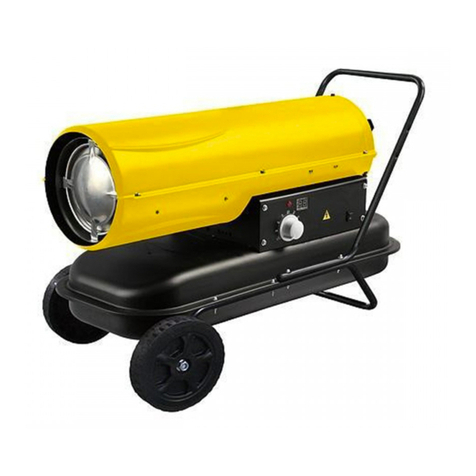
Strend Pro
Strend Pro BG01601-20 instruction manual
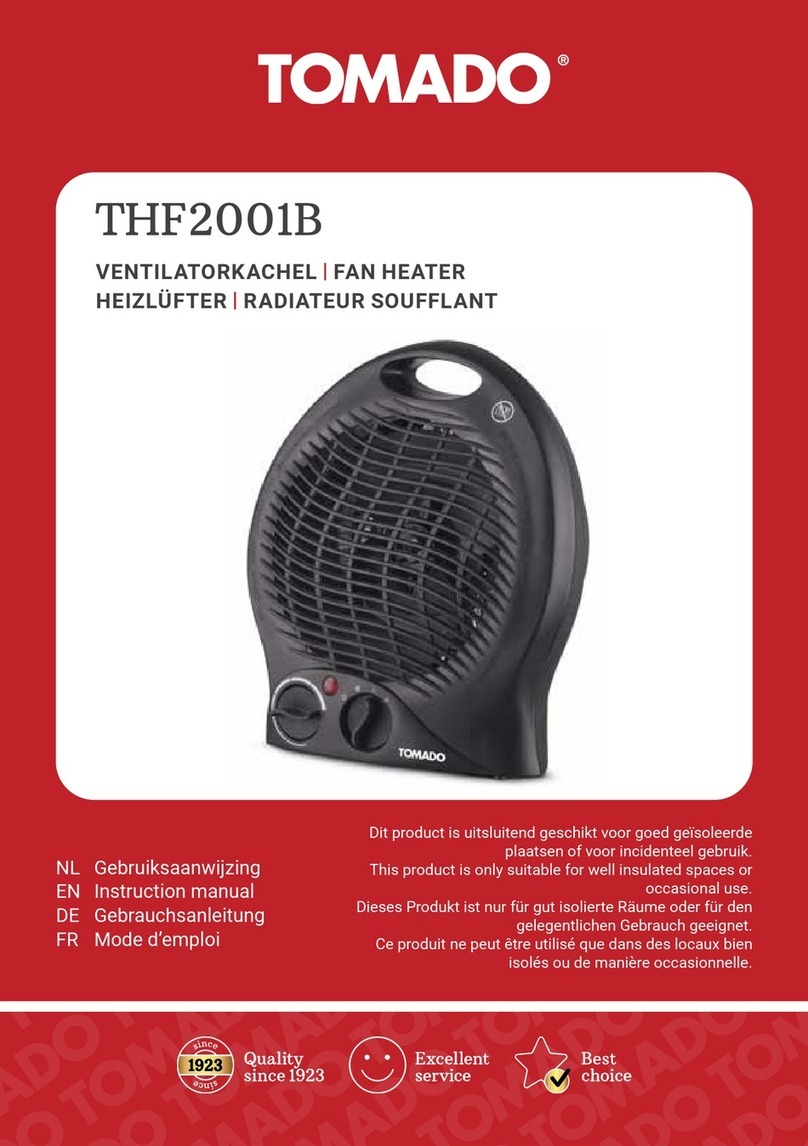
tomado
tomado THF2001B instruction manual
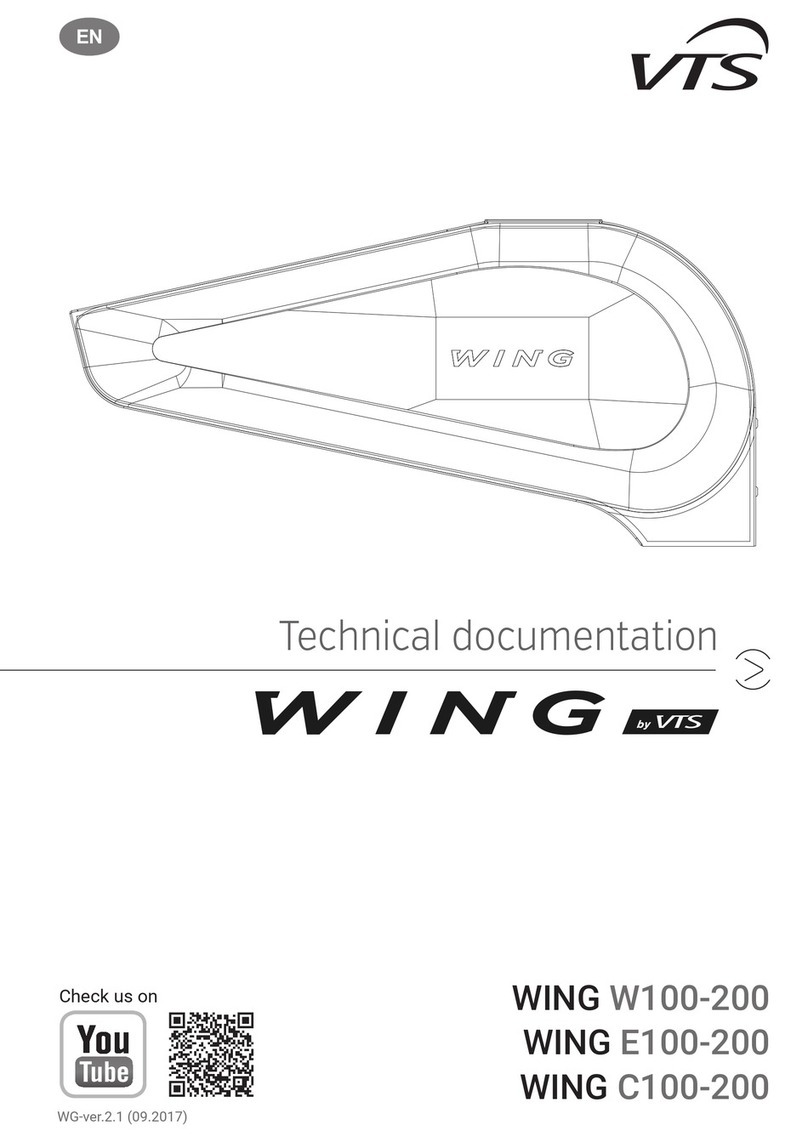
VTS Medical Systems
VTS Medical Systems WING W Series Technical documentation

